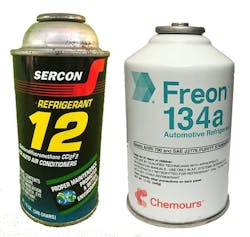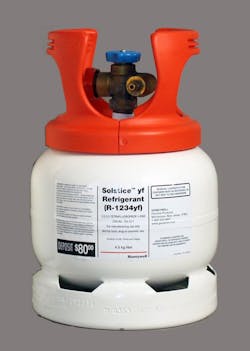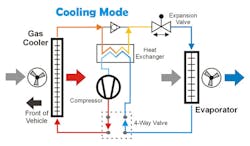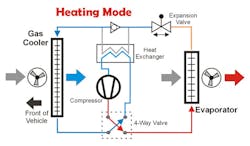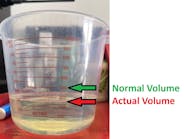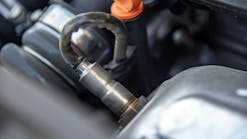Editor's Note:
Since the implementation of EPA regulations will eventually starve the automotive industry of R134a, a push for replacement refrigerants has been in play for years. The topic of R-744 (CO2) being a danger in automotive use was presented early, and honestly, I believed it wouldn't come to be here in the US. However, with the push for full-electric vehicles (EVs), it's necessary that these A/C systems can function as a heat pump as well. Heating an EV's cabin using energy from the HV battery could rob the range of the vehicle by up to 50 percent. Although the currently used R1234yf is also capable of functioning within a heat pump system, its functionality will cease in temperatures below 23°F, making many regions of the United States a not-so-welcoming place for R1234yf. I don't believe the R1234yf refrigerant is here to stay but instead a steppingstone toward eventual implementation of R-744, or something else. I guess time will tell.
- Technical Editor Brandon Steckler, Feb. 4, 2022This article has been updated from its original 2018 posting.
The latest EPA regulations require new vehicles offered for sale (starting in the 2021 model year) to use a refrigerant other than R134a. OEMs have also been incentivized to use these alternatives before the phase-out deadline as they can earn emissions credits by making the change early. These tradable credits helped manufacturers comply with new, stricter fuel economy standards. Remember the switch from R-12 to R-134a? Will this refrigerant transition be the same? Not exactly.
R-134a is not going to disappear in the same way as CFCs (chlorofluorocarbon) or R-12 did. R-12 was phased out in accordance with the Montreal Protocol in the 1990s, as it was found that the chlorine contained in the refrigerant was creating a hole in the ozone layer when it was vented into the atmosphere. This phase-out came in two parts. The first was that no vehicles from 1994 on could be manufactured or imported that used CFC refrigerants. A/C systems in new cars had to use hydrofluorocarbons (HFCs) or what is commonly called R-134a. The second part of the phase-out was the mandatory reduction in the supply of R-12 and U.S. production and imports of CFCs containing chlorine were cut. No R-12 refrigerant has been manufactured since 1996 and the only supplies left are “virgin” (original containers) or refrigerant that has been legally recovered and reclaimed.
In 2006, the European Union (EU) came out with a directive known as 2006/40/EC. Their goal was to reduce the emissions of fluorinated greenhouse gases from automotive air conditioning systems with a gradual phase-out across the EU. The first major date of the phase-out was 2008, then 2011, and then finally on Jan. 1, 2017, any new vehicle using a refrigerant with a Global Warming Potential (GWP) higher than 150 would be banned.
Regarding refrigerants, the EU’s action was a precursor for what transpired in the U.S. In 2015, the Environmental Protection Agency (EPA) announced a new rule under their Significant New Alternatives Policy, or SNAP, called Rule 20. This rule dictated the eventual phase-out of HFC refrigerants, including R-134a, across the United States. The basis of the rule was that by the year 2020, or MY 2021, all new manufactured or imported vehicles would not be able to use R-134a. There is room for a few exclusions, but these can only push the date back to 2025.
Why is R-134a being phased out?
Unlike R-12, R-134a does not contain chlorine and does not damage the ozone layer. However, R-134a has a high GWP, which is a relative measure of how much heat a greenhouse gas traps in the atmosphere when compared to the amount of heat trapped by carbon dioxide (CO2). Those familiar with 5-gas analyzer readings from a vehicle’s exhaust know that high CO2 readings indicate a nearly ideal air-fuel ratio, efficient combustion, and optimum catalytic converter operation. While high CO2 readings from a car’s exhaust may seem like a good thing, CO2 is a greenhouse gas that contributes to global warming. GWP is expressed as a factor of carbon dioxide where its GWP is equal to 1. The GWP for R-134a refrigerant is 1,430, making it 1,430 times more harmful than carbon dioxide when released into the atmosphere.
There are three refrigerants that can be used to replace R-134a: R-1234yf, R-152a, and R-744. More on these replacements later. An interesting fact about the phase-out of R-134a is that unlike the switch from R-12 to R-134a, there is no mandatory reduction in either production or importing of the refrigerant, which means that supplies of R-134a should be stable both in availability and cost. However, the demand will start shrinking with each passing year because no new vehicles after 2020 will be able to use it. Over the next 10 or so years, vehicles that use R-134a will inevitably end up in junkyards and the production of R-134a will be reduced, then disappear completely. Instead of a phase-out, R-134a will be economically starved out of existence.
R-1234yf refrigerant
To date, most auto manufacturers are using the hydro fluoro olefin (HFO) refrigerant R-1234yf as the replacement of choice for R134a. The 2013 Cadillac XTS was the first U.S.made vehicle to use the new refrigerant. With a GWP of 4 (instead of 1,430 for R-134a), R-1234yf is more environmentally friendly. Unlike the transition between R-12 and R-134a, there will be no conversions between R-134a and R-1234yf. Due to the price of R-1234yf, some DIYers and a few shops may make under-the-table conversions. The two systems have different designs, components, and service ports. General Motors, Chrysler, and other manufacturers have chosen R-1234yf as the refrigerant to replace R-134a. Honeywell, DuPont, and other major manufacturers are pushing the use of R-1234yf as the best alternative to R-134a, but this trend is not without controversy.
German manufacturers Daimler, Volkswagen, and others do not want to use R-1234fy in their vehicles but will do so for the near future to meet U.S. refrigerant regulations. Their reasoning stems from safety testing simulating head-on collisions, performed by Daimler in 2012. Daimler claims that R-1234yf ignited when the compressor ruptured and the refrigerant came in contact with the hot engine. In addition, they found that burning R-1234yf emits toxic hydrogen fluoride gas. In an accident, occupants could possibly choke to death on the toxic gas while trying to escape the vehicle. The German Transit Authority, as well as DuPont and Honeywell, did their own testing and concluded that there was little risk from the use of R-1234yf, contradicting Daimler’s test results. Nevertheless, Daimler, Volkswagen, Porsche, Audi, and BMW are going forward and developing A/C systems that use R-744 for use in select vehicles for the European market. Currently, the Audi A8, Volkswagen’s Phaeton, and Mercedes E-class and S-class vehicles use R-744 in Europe.
An interesting aspect of the debate regarding which refrigerant is the best replacement for R-134a may have something to do with cost. At the time this article was initially writted, R-134a costed about $120 for a 30 lb cylinder. R-1234yf costed around $700 for a 10 lb cylinder and R-744 costed $68 to fill a 100 lb cylinder. The cost per pound worked out as follows: R-134a at $4, R-744 at 68 cents, and R-1234yf at $70 per pound. Although prices have changed since then, it doesn’t take a degree in economics to determine that selling R-1234yf refrigerant at $70 per pound is more profitable than selling R-744 at 68 cents per pound. In the future, R-1234yf costs will be lower as production scales up and more OEMs are using it, but it will never be less expensive to produce than R-744, which is essentially CO2 – a waste product of the chemical industry. While R-744 systems will be initially expensive to manufacture, their cost will come down as more automakers employ these systems — especially on all-electric vehicles.
Technicians should have little difficulty adapting to R-1234yf as it has a similar pressure/temperature relationship and refrigeration cycle to R-134a. The expansion valve used for R-1234yf systems has an increased flow rate that compensates for a lower specific heat of evaporation. Other A/C system components will look similar to those used in R-134a systems. The EPA requires that service ports of systems that use different refrigerants be non-compatible, and R-1234yf service equipment will not connect to R-134a A/C systems. Another difference is the procedure for the recovery and recycling of R-1234yf as it is more time-consuming and utilizes more sophisticated leak and purity checks. In addition, the new refrigerant requires a dedicated, electronic or fluorescent leak detector. R-1234yf is classified as “mildly flammable” and contains hydrogen fluoride, which can form toxic hydrogen fluoride gas when in contact with a flame. To safely service R-1234yf systems, technicians should seek training in the nuances of the recovery and recharging process, as well as the variations in the system components and processes.
Of course, it has been a requirement for some time that technicians servicing any motor vehicle refrigerant system have EPA Section 609 certification. Most experts recommend that techs recertify, as the new test covers service and best practices for this and other new alternatives. Lastly, this certification is required before a technician can purchase any MVAC refrigerant (and not just R-12 as it had been prior to the Jan. 1, 2018 — effective date of the new ruling).
R-152a refrigerant
R-152a is the propellant used in aerosol sprays called “gas duster” products often called canned air used to blow off computer keyboards or other electronic components. For A/C use in automobiles, R-152a is a more efficient refrigerant than R-134a. It has zero Ozone Depletion Potential (ODP) and a low GWP of 124. However, it is moderately flammable and can present a fire hazard. Although it is difficult to ignite R-152a with only high-temperature surfaces or sparks as a source of ignition, it can be ignited by an open flame. This presents a potential safety concern in the case of a vehicle crash especially if the refrigerant is present in the passenger compartment.
To overcome the concern of leakage into the passenger compartment R-152a systems would use a secondary loop system that would keep the refrigerant contained under the hood and completely separate from passengers. In the secondary loop, the refrigerant cools a chiller (liquid–liquid heat exchanger) which in turn chills a water/glycol mixture that is pumped into the passenger compartment heat exchanger to provide cooling. Using R-152a has some advantages over R-134a. It takes less fuel to operate an R-152a A/C system. In addition, R-152a can use vehicle inertia to cool the secondary loop fluid and components during deceleration. To date, the Society of Automotive Engineers (SAE) is testing the practicality of using R-152a for production vehicle applications.
R-744 refrigerant
R-744 is the refrigerant name for carbon dioxide (CO2) and has been in use as a refrigerant since the mid-nineteenth century reaching its peak use in the 1920s. With the introduction of CFCs that operated at much lower pressures, the use of CO2 as a refrigerant declined. While many automotive manufacturers are using R-1234yf in new vehicles, German brands like Volkswagen, Porsche, Audi, and BMW have committed to R-744 as their refrigerant of choice. However, they will use R-1234yf for vehicles sold in the U.S. For its vehicles that use R-1234yf, Daimler will add an underhood “fire extinguisher” that consists of an argon gas canister with spray lines directed at all parts that could come in contact with leaking refrigerant. Systems that use R-744 will have pressures up to ten times higher than those of R-134a or R-1234yf systems. Summertime temperatures can produce system pressures of 1450 psi (100 bar) or higher and adapting CO2 systems for automotive applications presents a significant engineering challenge requiring unique components and system layouts.
CO2 is naturally present in the air we breathe at a concentration of 0.037 percent and is not harmful. CO2 in high concentrations is recognized as a hazard. At sea-level pressure, and room temperature, CO2 is a colorless, odorless gas and therefore undetectable even at elevated concentrations. As the concentration of CO2 in the air rises it can cause headaches, dizziness, confusion, and loss of consciousness. Because CO2 is heavier than air it displaces oxygen and fatalities from asphyxiation have occurred when high concentrations of CO2 are present in confined spaces such as tanks, sumps, or cellars. With the windows rolled up on a hot day the interior of a vehicle would not be a good place to be if there is a refrigerant leak. Vehicles using R-744 have cabin air quality sensors that detect refrigerant leaks and let in fresh air if R-744 concentrations exceed 800 parts per million (average atmospheric levels are below 400ppm). Even working under the hood with R-744 in a closed shop environment could be a safety hazard. For technicians, the combined chemical hazard and extremely high operating pressures of R-744 will require specialized equipment as well as certification training.
The compressor in an R-744 system works under high median effective pressure and the pressure ratio (discharge pressure to suction pressure) is relatively low when compared to an R-134a system. The pressure ratio to deliver identical refrigerating capacity between R-134a and R-744 favors the R-744 system. With a pressure ratio of 3.1 for R-744, vs. 5 for R-134a, the compressor used in R-744 systems is more efficient and physically smaller. Another advantage of R-744 systems is that there is no condensation of the refrigerant. Appearing similar, and located in front of the vehicle’s radiator, a gas cooler replaces the condenser. The gas cooler rejects heat from the refrigerant at higher pressures than those generated in an R-134a system, has better heat transfer, and allows for higher velocities of refrigerant flow.
In the R-744 refrigerant cycle, heat transfer takes place at supercritical temperatures and the refrigerant cycle is transcritical, meaning it has a subcritical low-pressure side and a supercritical high-pressure side. Unlike R-134a systems when R-744 is subject to supercritical pressures, the pressure of the refrigerant is independent of its temperature.
This means that for a given evaporation temperature, and minimum heat rejection temperature on exit from the cooler, a transcritical cycle has a greater thermodynamic loss (cooling capacity) than the condensation cycle used on R-134a systems.
The cons for using R-744 refrigerant are high initial cost for development (components must be designed for high pressures), in-vehicle and service equipment leak detection sensing required, specialized training for technicians, safety issues related to asphyxiation, and high system pressures. The pros for using R-744 as a refrigerant are non-flammable, non-toxic to the environment (GWP of 1), low cost (waste product of the chemical industry with global availability), smaller A/C components, no recovery or recycling required (developing countries only), and heat pump capability for electrical vehicles. R-744 systems not only control in-cabin temperature but also humidity and air velocity permitting automatic switching between external and internal air circulation. When used in multi-zone automatic A/C systems, it is possible to create an optimal microclimate for each individual passenger.
Electric vehicles can’t be left out of any discussion regarding what type of refrigerant will dominate A/C systems of the future. Each year more electric vehicles become available in the marketplace and it’s only a matter of time before gasoline and diesel-powered transportation will be uncommon and eventually eliminated. In an all-electric vehicle, heating the passenger compartment using energy from the battery can reduce driving range by up to 50 percent. To solve this problem the A/C systems on electric cars will have to have heat pump functionality. Both R-1234yf and R-744 have heat pump capabilities, however, in the case of R-1234yf, the heat pump function will only work as long as outside temperatures are above 23° degrees F. (-5°C). If the temperature falls below this level, additional energy from the vehicle’s battery will be needed to provide heat. By contrast, R744 heat pumps supply more heat at temperatures below 23 degrees F.
In conclusion, R-744 A/C systems are more energy-efficient and have greater cooling capacity than those that use R-1234yf. With fuel economy as a consideration, it takes more energy to power a vehicle with an R-1234yf A/C system than one using R-744. Combined with its limited heat pump capacity R-1234yf is probably only a temporary solution for the replacement of R-134a while low-cost R-744 has more promise for use in electric vehicles. R-1234yf will be in use for many years but in the distant future, R-744 may ultimately replace it.

